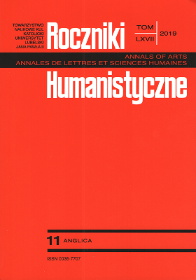Cirencester’s Ancient Name: Corinium or Carinium?
Abstrakt
Starożytna nazwa Cirencester: Corinium czy Carinium?
Cirencester, leżące około pięćdziesięciu kilometrów ma zachód od Oksfordu, jest angielską miejscowością w miejscu rzymskiego miasta. I chociaż jego pierwotną nazwą było ponoć Corinium (stąd Ciren- w Cirencester), nie było to nigdy satysfakcjonującą etymologią. Walijskie câr i irlandzkie cara (‘przyjaciel’) pozwala na korektę Corinium do Carinium (‘miejsce Carinosa’), oznaczającego ‘miejsce umiłowanego małego przyjaciela’ i spójnego w rozwoju z Ciren-. Tajemnica otaczająca Cirencester, stolicę Dobunni, wydaje się zatem rozwiązana. Za pierwsze Carinium uznać można pobliską cytadelę Bagendon Dykes. Kiedy Rzymianie okupowali ten rejon, założyli pięć kilometrów dalej miasto, przenosząc tam lokalną ludność i zachowując nazwę starej osady (jak miało to miejsce w innych częściach Brytanii, takich jak Colchester, St Albans, Wroxeter). Wydaje się więc, że nazwę swą współczesne Cirencester zawdzięcza Carinusowi albo Carinosowi, nieznanemu Brytonowi, który okupował Bagedon około dwóch tysięcy lat temu.
Bibliografia
Breeze, Andrew. “Two Ancient Names: Britanni and Londinium,” Eos 101, 2014, pp. 311–23
Breeze, Andrew. “Buckland Monachorum and Dobunnus the Smith,” Devon and Cornwall Notes and Queries, 41 (2016), no. 10, pp. 315–19
Breeze, Andrew. “Gildas and the Schools of Cirencester,” The Antiquaries Journal, vol. 90, 2010, pp. 131–8
Brook, George Leslie. An Introduction to Old English. Manchester UP, 1955.
Campbell, Alistair. Old English Grammar. Clarendon Press, 1959.
Charles-Edwards, Thomas M. Wales and the Britons 350–1064. Oxford UP, 2013.
Coates, Richard. “Rethinking Romano-British *Corinium,” The Antiquaries Journal, vol. 93, 2013, pp. 81–91
Coates, Richard, and Andrew Breeze. Celtic Voices, English Places. Shaun Tyas, 2000.
Dark, K. R. Civitas to Kingdom. Leicester UP, 1995.
Ekwall, Eilert. The Concise Oxford Dictionary of English Place-Names. Clarendon Press, 1936.
Evans, D. Ellis. Gaulish Personal Names. Clarendon Press, 1967.
Falileyev, Alexander, Ashwin E. Gohil, and Naomi Ward. Dictionary of Continental Celtic Place-Names. CMCS Publications, 2010.
Field, John. Place-Names of Great Britain and Ireland. David and Charles, 1980.
Frere, Sheppard S. “Dobunni.” In The Oxford Classical Dictionary, 2nd ed., edited by Nicholas Geoffrey Lemprière Hammond and Howard Hayes Scullard. Clarendon Press, 1970, p. 357.
Higham, Nicholas J. King Arthur: The Making of the Legend. Yale UP, 2018.
Geiriadur Prifysgol Cymru: A Dictionary of the Welsh Language. Gwasg Prifysgol Cymru, 1950–2002.
Gelling, Margaret. “Cirencester.” The Names of Towns and Cities in Britain, edited by W[ilhelm] F[ritz] H[ermann] Nicolaisen. Batsford, 1970, pp. 74–5.
Gelling, Margaret. Signposts to the Past. Dent, 1978.
George, Karen. Gildas’s ‘De Excidio Britonum’ and the Early British Church. Boydell, 2009.
Halsall, Guy. Worlds of Arthur. Oxford UP, 2013.
Jackson, Kenneth. Language and History in Early Britain. Edinburgh UP, 1953.
Jackson, Kenneth Hurlstone. “The British Language during the Period of the English Settlements.” Studies in Early British History, edited by Nora K. Chadwick. Cambridge UP, 1954, pp. 61–82.
Kaczmarczyk, Zdzisław. Miasta Dalmatyńskie do początku XV wieku: Przegląd i obraz urbanistyczny. PIW, 1976.
Koch, John T. An Atlas for Celtic Studies. Oxpens, 2007.
Lewis, Henry. Yr Elfen Ladin yn yr Iaith Gymraeg. Gwasg Prifysgol Cymru, 1943.
Owen, Hywel Wyn, and Richard Morgan. Dictionary of the Place-Names of Wales. Gomer, 2007.
Parsons, David N. “Classifying Ptolemy’s English Place-Names.” Ptolemy: Towards a Linguistic Atlas of the Earliest Celtic Place-Names of Europe, edited by David N. Parsons and Patrick Sims-Williams. CMCS, 2000, pp. 169–78.
Pedersen, Holger, and Henry Lewis. A Concise Comparative Celtic Grammar. Vanderhoeck and Ruprecht, 1937.
Pevsner, Nikolaus. The Buildings of England: Buckinghamshire. Penguin, 1960.
Potkowski, Edward. “Kościoły terytorialne i państwowe we wczesnym średniowieczu.” Katolicyzm wczesnośredniowieczny, PIW, 1973, pp. 9–112.
Reaney, Percy Hide. The Origin of English Place-Names. RKP, 1960.
Reece, Richard. My Roman Britain. Cirencester: privately printed, 1988.
Rivet, A. L. F. Town and Country in Roman Britain. Hutchinson, 1958.
Rivet, A. L. F., and Colin Smith. The Place-Names of Roman Britain. Princeton UP, 1979.
Room, Adrian. Dictionary of Place-Names in the British Isles. Bloomsbury, 1988.
Sims-Williams, Patrick. Ancient Celtic Place-Names in Europe and Asia Minor. Blackwell, 2006.
Sims-Williams, Patrick. “Language: Brittonic Period.” A Corpus of Early Medieval Inscribed Stones and Stone Sculpture in Wales, III: North Wales, edited by Nancy Edwards, UWP, 2013, p. 322.
Thomas, R. J. Enwau Afonydd a Nentydd Cymru. Gwasg Prifysgol Cymru, 1938.
Toller, T. Northcote, editor. An Anglo-Saxon Dictionary. Clarendon, 1898.
Vendryes, J. Lexique étymologique de l’irlandais ancien: Lettre C. CRNS, 1987.
Verey, David. The Buildings of England: Gloucestershire I, The Cotswolds, Penguin, 1979.
Wacher, John. The Towns of Roman Britain. RKP, 1974.
Watts, Victor, editor. The Cambridge Dictionary of English Place-Names. Cambridge UP, 2014.
Williams, Ifor. The Beginnings of Welsh Poetry. University of Wales Press, 1972,
Williams, Ifor, editor. Armes Prydein. DIAS, 1972.
Copyright (c) 2019 Roczniki Humanistyczne

Utwór dostępny jest na licencji Creative Commons Uznanie autorstwa – Użycie niekomercyjne – Bez utworów zależnych 4.0 Międzynarodowe.





